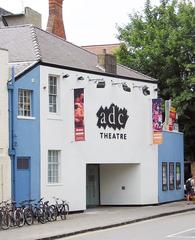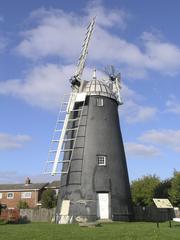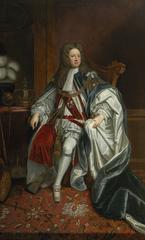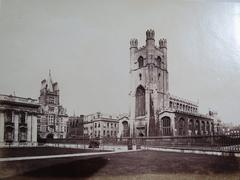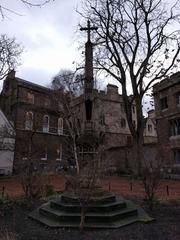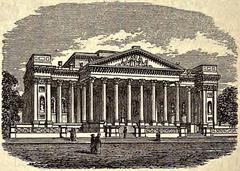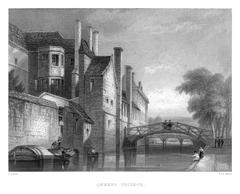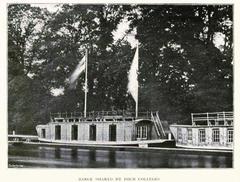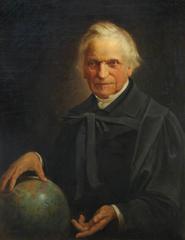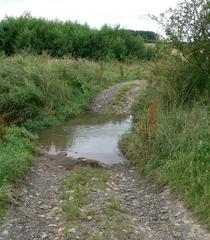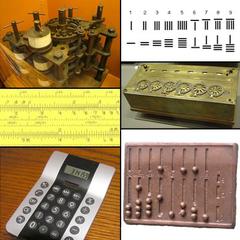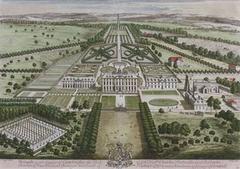Visiting The Museum of Cambridge: Hours, Tickets, and Travel Tips
Date: 31/07/2024
Introduction
The Museum of Cambridge, situated in the heart of Cambridge, United Kingdom, offers an enriching journey through the social history of the region, spotlighting the everyday lives of its inhabitants over the past three centuries. Established in 1936 and originally known as the Cambridge & County Folk Museum, the institution is housed in the historic White Horse Inn, a 16th-century Grade II listed public house (Wikipedia). The museum’s origins can be traced back to a successful exhibition titled ‘A Festival of Olden Times’ in 1933, organized by the Cambridgeshire Federation of Women’s Institutes, which ignited a collective passion for preserving local heritage (Wikipedia).
Over the decades, the Museum of Cambridge has amassed a diverse collection of over 20,000 objects, including applied art, costumes, fine art, and more, offering a tangible connection to the past (Wikipedia). The museum has faced numerous challenges, including financial difficulties and potential relocation issues, yet it has shown remarkable resilience, particularly during the COVID-19 pandemic when a successful fundraising campaign ensured its survival (Wikipedia).
In addition to its rich collection, the museum is actively engaged in community projects like ‘Capturing Cambridge,’ an initiative to document local history through crowdsourced stories and memories (Wikipedia). This guide aims to provide a comprehensive overview of the Museum of Cambridge, covering its history, visiting information, current exhibitions, and future prospects, ensuring that your visit is both educational and memorable.
Table of Contents
- History and Significance of The Museum of Cambridge
- Visitor Information
- Community Engagement
- Significance in the Context of Cambridge
- Preservation of Local Heritage
- Educational Impact
- Future Prospects
- FAQ
History and Significance of The Museum of Cambridge
Origins and Early Development
The Museum of Cambridge, originally known as the Cambridge & County Folk Museum, has a rich history that dates back to the early 20th century. The museum was established following a successful exhibition organized by the Cambridgeshire Federation of Women’s Institutes in 1933, titled ‘A Festival of Olden Times,’ held at Cambridge’s Guildhall (Wikipedia). This exhibition showcased various artifacts and memorabilia from the region, sparking interest in preserving the local heritage.
The museum officially opened its doors in 1936, housed in the former White Horse Inn, a Grade II listed 16th-century public house that had closed in 1934 (Wikipedia). The building itself is a significant historical artifact, providing an authentic backdrop for the museum’s extensive collection.
Growth and Expansion
The museum’s collection grew rapidly in its early years. By 1939, the collection had expanded to over 1,900 exhibits, thanks in part to donations from notable figures such as Queen Mary, who visited the museum in 1938 and contributed a miniature table and a tea caddy the following year (Wikipedia). This period marked the beginning of the museum’s role as a custodian of local history and culture.
Challenges and Resilience
The museum faced several challenges throughout its history. In 1945, there were concerns that the building would be required for a town improvement scheme, necessitating a search for a new home. However, this did not come to pass, and the museum remained in its original location (Wikipedia). Financial difficulties also plagued the museum, particularly in 1988 and again in 2017, when it faced the threat of closure due to funding shortages (Wikipedia).
Despite these challenges, the museum has shown remarkable resilience. In 2020, during the COVID-19 pandemic, the museum launched a successful fundraising campaign with the support of Cambridge MP Daniel Zeichner, allowing it to reopen to the public in May 2021 (Wikipedia).
Curatorial Leadership
One of the most significant figures in the museum’s history is Enid Porter, who served as Curator from 1947 to 1976. Porter was a leading authority on Cambridgeshire culture, history, customs, and beliefs, and she played a pivotal role in expanding the museum’s collection and its reputation as a center for local history (Wikipedia). Her contributions to the field of oral history and her dedication to preserving local traditions have left a lasting legacy.
Collection Highlights
The Museum of Cambridge boasts a diverse collection of over 20,000 objects that reflect the social history of Cambridge and the surrounding area from 1700 onwards. The collection includes applied art, coins, costumes, decorative art, fine art, hobbies, law and order, medals, medicine, music, social history, textiles, and toys (Wikipedia). Notable items include oil paintings by local artist Mary Charlotte Greene (1860-1951) and inn signs by Richard Hopkins Leach (1794-1851) (Wikipedia).
Visitor Information
Visiting Hours
The Museum of Cambridge is typically open from Tuesday to Saturday, 10:30 AM to 5:00 PM, and on Sundays from 12:00 PM to 4:00 PM. It is closed on Mondays and bank holidays. Always check the official website for the most up-to-date information on opening hours.
Tickets
Ticket prices for the Museum of Cambridge are as follows:
- Adults: £5.00
- Concessions (students, seniors): £3.00
- Children under 12: Free
Family and group tickets are also available. Tickets can be purchased at the museum entrance or online via the museum’s official website.
Travel Tips
The Museum of Cambridge is located at 2-3 Castle Street, Cambridge, CB3 0AQ. It is easily accessible by public transport, with several bus routes stopping nearby. The museum is also within walking distance from the city center. Limited parking is available on site, and there are several public car parks in the vicinity.
Nearby Attractions
While visiting the Museum of Cambridge, consider exploring other nearby attractions such as the Fitzwilliam Museum, the Sedgwick Museum of Earth Sciences, and the Cambridge University Botanic Garden. These sites offer a broader perspective on Cambridge’s rich cultural and academic heritage.
Accessibility
The museum is committed to providing an accessible experience for all visitors. There are ramps and lifts available for wheelchair users, and assistance dogs are welcome. For specific accessibility needs, it is recommended to contact the museum in advance.
Community Engagement
The museum is not just a repository of artifacts; it is also an active participant in the community. It operates as an independent charity governed by a board of trustees and administers ‘Capturing Cambridge,’ a website that crowdsources local history, documenting stories and memories across Cambridge and the surrounding area street by street (Wikipedia). This initiative helps to engage the community and preserve the living history of the region.
Significance in the Context of Cambridge
The Museum of Cambridge holds a unique position within the broader context of Cambridge’s rich cultural and academic landscape. While the city is renowned for its prestigious university and numerous academic museums, the Museum of Cambridge offers a different perspective by focusing on the everyday lives of the local people. This focus on social history complements the more scholarly collections found in other institutions, such as the Fitzwilliam Museum and the Sedgwick Museum of Earth Sciences (Culture Trip).
Preservation of Local Heritage
The museum’s role in preserving local heritage is invaluable. It provides a tangible connection to the past, allowing visitors to explore the customs, traditions, and daily lives of the people of Cambridgeshire. The museum’s collection serves as a historical record, documenting the evolution of the region over the centuries. This preservation of local heritage is crucial for fostering a sense of identity and continuity within the community.
Educational Impact
The Museum of Cambridge also plays an important educational role. It offers a range of programs and activities designed to engage visitors of all ages. These include guided tours, workshops, and special exhibitions that provide deeper insights into the region’s history and culture. By making history accessible and engaging, the museum helps to inspire a new generation of historians and cultural enthusiasts.
Future Prospects
Looking ahead, the Museum of Cambridge is well-positioned to continue its mission of preserving and promoting local history. The successful fundraising campaign in 2020 demonstrated the community’s strong support for the museum, and ongoing initiatives like ‘Capturing Cambridge’ ensure that the museum remains relevant and connected to the community it serves. As it moves forward, the museum will undoubtedly continue to play a vital role in the cultural life of Cambridge.
FAQ
Q: What are the visiting hours for the Museum of Cambridge? A: The museum is open from Tuesday to Saturday, 10:30 AM to 5:00 PM, and on Sundays from 12:00 PM to 4:00 PM. It is closed on Mondays and bank holidays.
Q: How much are the tickets for the Museum of Cambridge? A: Ticket prices are £5.00 for adults, £3.00 for concessions (students, seniors), and free for children under 12.
Q: How can I get to the Museum of Cambridge? A: The museum is located at 2-3 Castle Street, Cambridge, CB3 0AQ. It is accessible by public transport and within walking distance from the city center.
Q: Is the Museum of Cambridge accessible for disabled visitors? A: Yes, the museum has ramps and lifts available for wheelchair users, and assistance dogs are welcome. For specific accessibility needs, please contact the museum in advance.
Conclusion
The Museum of Cambridge stands as a testament to the rich social history and cultural heritage of the Cambridge region. Despite facing numerous challenges over the years, from financial crises to potential relocation, the museum has persisted and thrived, thanks in large part to community support and dedicated leadership (Wikipedia). Its diverse collection of over 20,000 artifacts provides invaluable insights into the lives of ordinary people, complementing the more academic focus of other local institutions like the Fitzwilliam Museum and the Sedgwick Museum of Earth Sciences (Culture Trip).
The museum’s role extends beyond being a repository of artifacts; it actively engages with the community through initiatives like ‘Capturing Cambridge’ and seasonal events that promote wellbeing and self-expression (Museum of Cambridge). Educational programs and guided tours further enrich the visitor experience, making the museum a vital educational resource for people of all ages.
As the Museum of Cambridge looks to the future, it remains committed to preserving and promoting local history, ensuring that future generations can connect with their heritage. The successful initiatives and strong community support bode well for its continued relevance and impact. Whether you’re a history enthusiast, a family looking for educational activities, or a tourist exploring Cambridge, the Museum of Cambridge offers a unique and enriching experience that is well worth a visit. Plan your visit today and stay updated with the latest events and exhibitions by following the museum on social media or visiting their official website.
References
- Museum of Cambridge Wikipedia
- Museum of Cambridge Museum of Cambridge
- Top Museums in Cambridge to Visit Culture Trip
- Museum of Cambridge Events Museum of Cambridge
- Hidden Cambridge Tour Eventbrite
